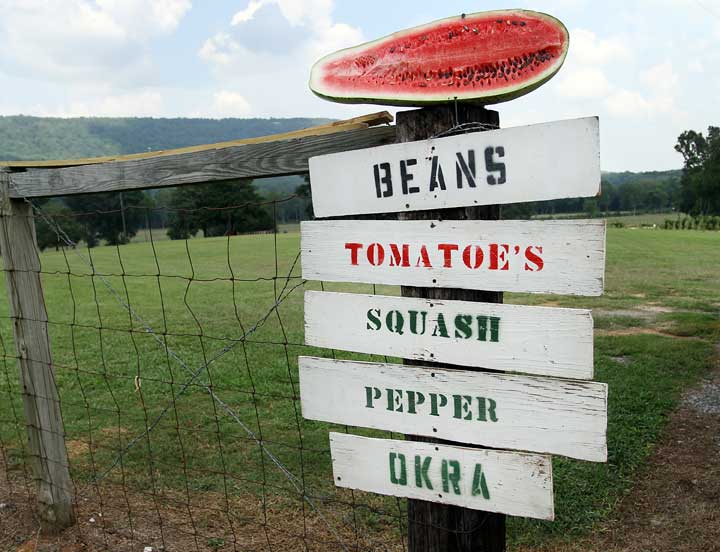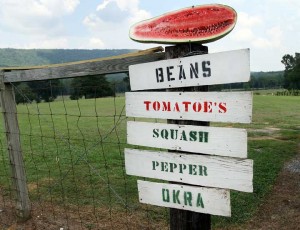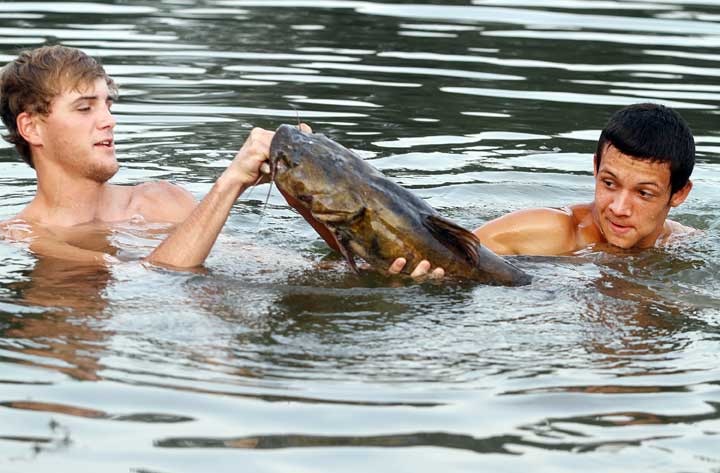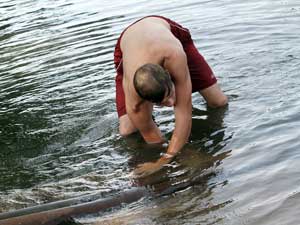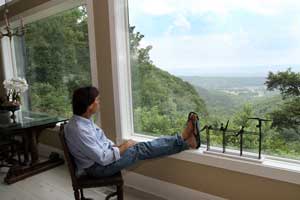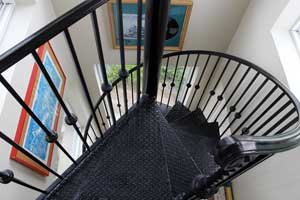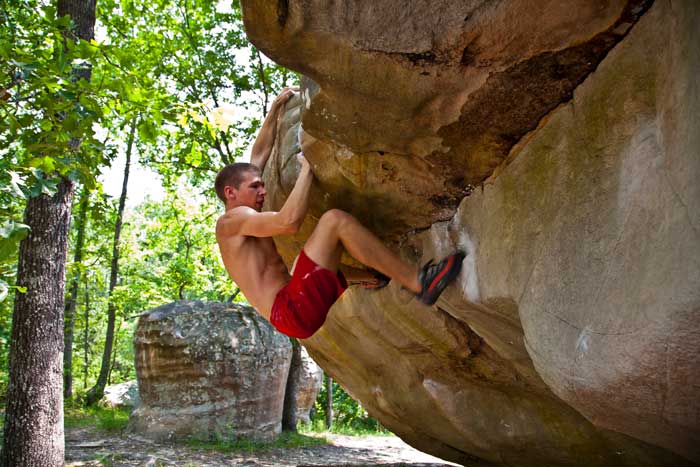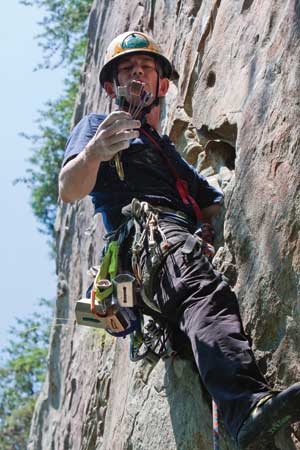 By Loyd McIntosh
By Loyd McIntosh
Photos by Jerry Martin and Loyd McIntosh
On a blazing hot Saturday in mid-June, Gary Liverett drives his white pickup truck onto the property of Alpha Ranch, the ministry for young adult boys he founded more than 20 years ago. Fresh from picking up his son, Chris, a real estate agent in Colorado, from the airport in Birmingham, Liverett takes a seat under a tent that serves as a meeting place, a work space and a welcome respite from the heat of the summer sun.
It’s been almost six weeks since the deadly tornadoes of April 27 tore through this remote section of St. Clair County. In just a three-mile stretch along County Highway 22, 15 people lost their lives; none, however, at Alpha Ranch. In fact, 37 people survived the storm in one of two homes on the property, despite the loss of the entire ranch to the storm.
There are signs of progress on the ranch. For instance, the wood frame for a new shop has been erected and most of the debris has been removed, but there are still tons of reminders all around. Liverett is still in the process of making sense of all that transpired.
As fate would have it, Liverett was recuperating from a heart attack at UAB Hospital on that devastating day in April. Helplessly, Liverett could do nothing but watch the television coverage as the storm moved from Tuscaloosa County into Jefferson and, finally, into St. Clair. “The first news we saw that pinpointed the area was Channel 6, I guess, I’m not sure, but they said it was dead on Highway 22, and I knew that was us,” Liverett recalls. “My wife called and got word that nobody was injured, but that we had lost everything.”
Three days later, Liverett finally got a first-hand look at the destruction caused by the tornado. His son, Chris, and other family members had tried to prepare him with photos and news of all that had transpired. He knew, for instance, that 13 people had lost their lives in a three-mile stretch. He knew that both houses at the ranch, the barns, the shop and three cows were lost in the storm.
“I wept. I drove in …,” he pauses, unable to complete his sentence. Almost a full minute passes before he fully regains his composure and continues. “I still get emotional. As good as things are, it’s still hard to take.”
An independent and deeply spiritual man, Liverett is not one to say “why me” even when facing the prospect of starting over. While saddened at seeing everything he had worked to build over the 23 years, he believes that God is in control, and it is through his faith that he remains confident about what the future holds.
 “When we heard we had lost everything but I knew that everybody was safe, I was OK. I think God just really works in ways that we can’t explain,” Liverett says. “I really felt at peace. I was just blessed because I think God allowed us to see what things are really important to us.
“When we heard we had lost everything but I knew that everybody was safe, I was OK. I think God just really works in ways that we can’t explain,” Liverett says. “I really felt at peace. I was just blessed because I think God allowed us to see what things are really important to us.
“I guess God gives us the ability to process things in small segments at a time. If you had to process losing it all at one time, I don’t think you could take it,” he adds.
The good news is people like Liverett and others who lost everything — including loved ones — are already beginning the process of rebuilding. The events of April 27 revealed an ample supply of generosity, independence and strength of character of people throughout the community and beyond. St. Clair County is already bouncing back.
A COMMUNITY’S RESPONSE
Within hours of the storm, volunteers from the community sprang into action looking for survivors, assisting the injured, and helping in any way they can. As the hours turned into days, more help arrived from familiar organizations, such as the Red Cross and the Federal Emergency Management Agency (FEMA). And, according to Liverett and others on the scene, these agencies also brought with them top-heavy bureaucracies that sometimes made applying for and receiving help difficult.
What really made the difference was the response of the local religious community. “I know FEMA and Red Cross and all have their place, but nothing, and I can speak for a lot of people, nothing met the needs like local individuals, churches and other ministries that were just right there with volunteers,” he said. “You don’t have to fill out papers, you don’t have to wait days and days, and they had no strings attached,” says Liverett. “I’m not putting down any of these agencies, but most of them have only certain things they can do, whereas individual groups like Extreme Ministries, just right off the bat, committed to building several houses and structures in this area, and they’ve done all they can.”
Extreme Ministries, based in Pell City and founded by the Rev. Jeff Huey, specializes in mobilizing volunteers for construction-related projects. By the time mid-June rolled around, Huey had volunteers working at as many as eight sites around the county, including Ragland, where a group of adults and teenagers are working to rebuild a house for an uninsured man.
In the triple-digit temperatures, high humidity and intense thunderstorms arriving out of the clear blue, the mood on the construction site is serious but upbeat.
“One thing you see is a mighty good attitude,” says John O. Sims, a retired builder from Pell City.
At this site, there are people from churches near and far – Pell City, Moody, Trussville, even Dallas, Texas. While there is a definite spirit of community and desire to help their fellow man, most volunteers throughout the community are working primarily to serve God.
“Everybody’s doing this because they love the Lord, and they’re doing it because they feel it’s a way of serving Him. It gives you a good feeling knowing that you’re helping somebody out in trouble and doing it in God’s name,” says Sims.
“Everybody’s just willing to do whatever has got to be done and it’s all in the spirit of God. It’s just a wonderful experience,” adds Mike Caldwell, a Pell City resident and employee at the Honda plant in Lincoln. “The attitude of everybody is just ‘whatever I can do to help. We’ll get it done.’”
Fifteen-year-old resident Austin Hamer is one of dozens of young people form Moody Baptist Church spending the week doing what they can to help. A normal teenager for whom a typical summer day would be playing his guitar at home, Hamer says he’s proud to be a part of the volunteer effort.
“We’re here to help build Shoal Creek back and Ragland back. I’ve heard people who were just doubting and sounded like they were giving up,” says Hamer. “I think it’s really good that so many people have come to help out because a lot of people down here don’t have insurance, and the churches are, pretty much, the only ones doing anything around here.”
The aftermath of the storm was felt not only by the community’s people, but the animals as well. Family pets, horses, cows and other livestock that helped the rural communities devastated by the tornadoes earn a living were significantly disrupted. Not wanting to leave any life, human or animal, without help it needs, the community sprang into action.
Rhonda Johnson-Bowles, account manager and equine and wildlife specialist for Land-O-Lakes Purina, helped organize an effort to care for the area’s animals after counting her own blessings following the storm. Having lived in the Shoal Creek area for more than 25 years, she felt the need to help and volunteered her time and skills to the community. “I was blessed to be the dealer and not the one being done for,” Bowles says. “We started out just helping farmers and then on Friday, my boss sent me a truckload of feed.
“I just went door-to-door and started in Shoal Creek and if anyone that was affected had an animal I gave them a month’s worth of feed,” Bowles adds. Before long, donations of food and supplies were arriving on her doorstep from as far away as Michigan and Wisconsin. To date Land-O-Lakes Purina and other individual benefactors have donated over 58 tons of premium feed in the effort.
GIVING AND RECEIVING, AND GIVING AGAIN
Back at Alpha Ranch, Liverett is taking stock of this turn of events. For 23 years, he has been a giver. He’s given young men with nowhere to go a place to stay, given them a place to learn a trade and to take care of themselves, and given them hope. Most of all, he and his family have given them love, support and a chance to turn their lives around. Now he finds himself in an unfamiliar position but hopes to be back changing lives sooner rather than later.
“We learned a lot. I don’t like to be on the receiving end. I’d much rather be on the giving end, but I think, probably, had people not rallied behind us so much, I don’t know if I’d have the heart to start back or not,” says Liverett. “We’d worked so hard to establish the place. I’m 61 and to start over, I don’t know if I would have had it in me, but God has used those people, and I feel stronger now than I’ve ever felt.”
Even after a heart attack and the loss of his ranch, Liverett is working every day not only to rebuild Alpha Ranch but to help his neighbors that suffered so much in April. He’s donated the use of heavy equipment to others and the use of his land for meetings and even a few fundraising events. And as soon as construction on the new shop is complete, he’ll let anyone who needs to saw some wood or hammer a nail be able to use it.
“I hope my heart has gotten bigger toward helping people. Giving is not just giving when it’s comfortable or when it’s notable, but when it hurts or gives what you need,” Liverett says. “I’ve seen people do that here, and that’s really been a lesson to me.”
“We’re blessed,” Liverett adds. “We’ve had people reach out and help us, and I’m grateful for that. I really am.”



































